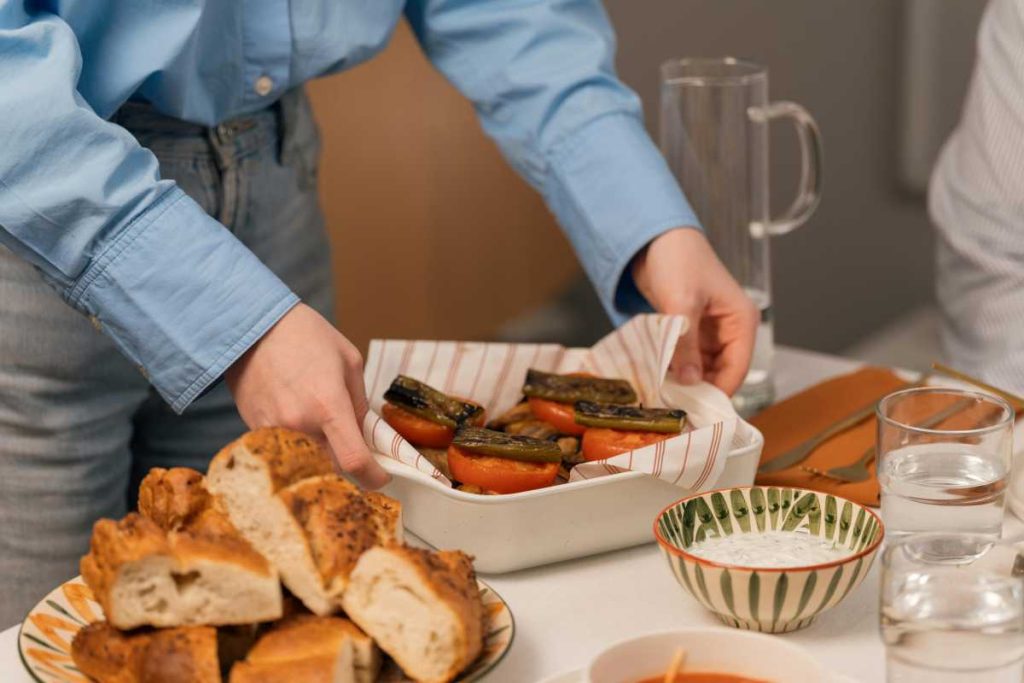In today’s fast-paced world, eating out has become a convenience that many of us rely on without giving it much thought. However, with restaurant meals often costing more and being packed with extra calories, adopting a “No Eating Out” mindset can be a game-changer. The No Eating Out Challenge is all about committing to cooking at home, with the dual benefit of saving money and making healthier choices. Whether you’re motivated by financial goals, health improvements, or just want to build cooking skills, this challenge offers a practical way to transform your lifestyle.
In this blog, we’ll cover the steps to start a No Eating Out Challenge, tips for meal planning and preparation, strategies to stay motivated, and the health and financial benefits of cooking at home. With a little commitment, you’ll find that this challenge isn’t just about meals—it’s about cultivating a mindset of self-sufficiency and well-being.
Benefits of the No Eating Out Challenge

1. Saves Money
One of the biggest perks of cooking at home is the savings. Restaurant meals and takeout often come with higher costs due to overheads, tips, and convenience fees. By choosing to cook at home, you can save significantly on each meal, allowing you to allocate funds toward other goals or hobbies.
2. Encourages Healthier Eating Habits
When you prepare your own meals, you control the ingredients and portions, leading to healthier food choices. Homemade meals can be tailored to suit your dietary needs, reduce processed ingredients, and lower the intake of unhealthy fats and sugars.
3. Reduces Food Waste
Meal planning as part of the No Eating Out Challenge can help reduce food waste. By shopping with a list and preparing meals at home, you’re more likely to use up ingredients and minimize leftovers, which helps both your wallet and the environment.
4. Builds Cooking Skills
Taking on the challenge encourages you to learn new recipes and develop cooking skills that can last a lifetime. Whether you’re new to the kitchen or looking to improve, the No Eating Out Challenge is a great way to boost confidence in your culinary abilities.
5. Promotes Mindful Eating
Preparing meals at home encourages a slower, more mindful approach to eating. Instead of quickly consuming takeout, you can sit down and enjoy meals you’ve created, leading to more satisfaction and awareness of portion sizes.
How to Start the No Eating Out Challenge
1. Set Clear Goals
Determine why you’re taking on this challenge. Are you looking to save a specific amount of money, eat healthier, or improve your cooking skills? Setting a clear goal will keep you motivated and give you a sense of accomplishment.
2. Create a Realistic Time Frame
Start with a manageable time frame, such as a week or a month, and gradually extend it if you feel confident. Taking on the challenge for too long initially may lead to burnout, so start small and celebrate each milestone.
3. Plan Your Meals

Planning meals is key to the success of this challenge. Look up recipes you’d like to try and create a weekly meal plan. Consider different types of meals, from quick breakfasts to hearty dinners, and include healthy snacks to avoid the temptation of takeout.
4. Build a Grocery List
Once you’ve planned your meals, make a list of all the ingredients you’ll need for the week. This helps you avoid impulse buys and ensures you have everything on hand to stick to your plan.
5. Set a Budget
Estimate the cost of groceries each week and set a budget. Track your spending to see how much you’re saving compared to previous months when you ate out more often.
Tips for Sticking to the No Eating Out Challenge
1. Meal Prep in Batches
Preparing meals in batches can make cooking at home much easier, especially on busy days. Set aside time once or twice a week to cook larger portions and store them for quick reheating.
2. Embrace Freezer-Friendly Recipes
Freezer meals are a lifesaver when you don’t have time or energy to cook from scratch. Make extra portions of your favorite meals and freeze them. Soups, stews, casseroles, and pasta dishes often freeze well.
3. Experiment with New Recipes
Trying new recipes keeps things exciting and prevents boredom with your meal choices. Look for recipes that fit your skill level and introduce you to new flavors and ingredients, helping you enjoy the process.
4. Stock Up on Essential Ingredients
Keep your pantry stocked with versatile essentials like grains, canned beans, pasta, and spices. Having these on hand allows you to whip up quick and easy meals without needing a grocery run.
5. Prepare Healthy Snacks
Prepare grab-and-go snacks to avoid the temptation of buying junk food or fast food. Things like veggie sticks with hummus, yogurt with fruit, and homemade granola bars are healthy, affordable options that satisfy cravings.
Overcoming Common Challenges

Lack of Time
If you find time to be a barrier, plan meals that are simple and quick to prepare. Stir-fries, sheet pan dinners, and salads with a protein source are all quick options that don’t compromise on nutrition or taste.
Cravings for Takeout
Cravings for takeout are common, especially if you’re used to eating out regularly. Try to recreate your favorite restaurant dishes at home. There are plenty of recipes online that mimic popular fast-food and restaurant meals.
Eating Out with Friends or Family
Social gatherings can be tricky when you’re on a No Eating Out Challenge. Offer to host and cook at home, or suggest a potluck-style get-together where everyone brings a dish. If eating out is unavoidable, plan ahead by reviewing the menu to choose healthy, budget-friendly options.
Health Benefits of the No Eating Out Challenge
Improved Nutritional Intake
Preparing meals at home allows you to focus on balanced nutrition. You’re more likely to eat a variety of fruits, vegetables, lean proteins, and whole grains, which leads to better overall health and energy levels.
Weight Management
With better control over portions and ingredients, many people find it easier to maintain or achieve a healthy weight while following the No Eating Out Challenge. Fewer hidden calories, sugars, and fats can make a noticeable difference.
Better Digestion
Homemade meals are often easier to digest than restaurant food, which can be high in sodium and oils. Fresh, wholesome ingredients reduce the chances of bloating or digestive discomfort.
More Energy and Focus
A balanced, home-cooked diet provides consistent energy and can improve mental clarity. You may find you have more focus and motivation for daily tasks as you cut back on highly processed foods.
Financial Benefits of the No Eating Out Challenge
Budget-Friendly Meal Planning
By preparing meals at home, you can buy ingredients in bulk and plan meals that fit your budget. Over time, the savings add up, allowing you to reallocate funds toward other priorities, like savings or personal projects.
Reduced Impulse Spending
Eating out often leads to impulse purchases, like an extra coffee or dessert. Cooking at home helps reduce these unnecessary costs, giving you more control over your spending.
Higher Return on Investment
Investing in quality ingredients and kitchen tools may require an upfront cost, but the benefits you gain over time far outweigh the expenses. Cooking at home can save hundreds of dollars each month compared to regular restaurant meals.
How to Stay Motivated
Celebrate Small Wins
Celebrate each milestone you achieve, whether it’s one week, two weeks, or a month without eating out. Treat yourself in other ways, like with a new kitchen gadget or a fun, non-food-related activity.
Track Your Progress
Keep track of the money you’re saving and any health improvements you’re noticing, such as weight loss, better digestion, or more energy. Seeing tangible results can help you stay committed.
Involve Friends or Family
The No Eating Out Challenge can be more enjoyable if you do it with friends or family. Share meal ideas, swap recipes, or even cook together to keep each other motivated.
Conclusion
The No Eating Out Challenge is a rewarding way to achieve both financial and health goals. By cooking at home, you’ll not only save money but also enjoy nutritious, personalized meals. This challenge encourages a mindful approach to food, fosters valuable cooking skills, and allows you to build healthier habits. Give it a try, and you might find that cooking at home is a simple change with lasting positive impacts! Whether you start for a week, a month, or make it a permanent habit, the No Eating Out Challenge is a lifestyle upgrade that brings lasting rewards.

